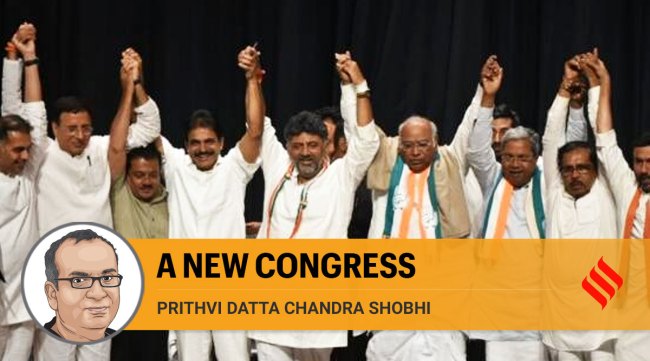Opinion How Congress won Karnataka: Strong local leadership and effective campaigning
Congress’ superior election management is visible in its dominance of old Mysuru, central Karnataka, Hyderabad Karnataka and Bombay Karnataka regions
 DK Shivakumar, Siddaramaiah, Mallikarjun Kharge, Randeep Surjewala and others during the press meet at KPCC, Bengaluru. (Express photos by Jithendra M)
DK Shivakumar, Siddaramaiah, Mallikarjun Kharge, Randeep Surjewala and others during the press meet at KPCC, Bengaluru. (Express photos by Jithendra M)
Regardless of who wins, let there be a clear mandate — this was a refrain heard across Karnataka during the recent assembly election campaign. It was quite natural that the common voter in the state was tired of repeated efforts to engineer defections and “resort stays” for power-seeking defectors in search of ministerial offices. Even with the strong desire for political stability, Congress Party’s stunning and emphatic victory in the assembly elections held on May 10 comes as a surprise. Both political pundits and voters had anticipated a much closer election and possibly a hung assembly, given the intense political competition in each constituency across the state.
In 2013, Congress had comfortably secured a simple majority in the state assembly against a much weaker opposition. Narendra Modi was still the chief minister of Gujarat and wasn’t the dominant political voice of Indian politics. The Karnataka BJP unit had splintered, as both B S Yediyurappa, its tallest leader, and B Sriramulu, its most popular OBC leader, left to form their own regional parties. Then Congress also had the advantage of being in power at the Centre and didn’t lack resources or access to investigative agencies.
Ten years later, Congress has performed spectacularly under very different circumstances and much tougher conditions. True, there was some dissent within BJP and two senior leaders resigned weeks before the elections. Denied tickets for themselves or for their family members, many others remained inactive. But the Modi-Shah duo camped in Karnataka in recent months and took personal charge of the election campaign. Modi, in particular, visited the state nearly a dozen times in 2023, inaugurating a slew of development projects and addressing tens of rallies. He dismissed allegations of massive corruption and inefficient governance levied against the BJP government in Karnataka while extolling the benefits of a “double engine” government. He also resurrected the old charges of corruption against Congress leaders. It is no surprise then that the central investigative agencies targeted D K Shivakumar, the Congress state party president, by repeatedly raiding his residence and summoning his family members for inquiries.
Yet, on the back of a dominant electoral performance in four out of the six subregions of Karnataka, Congress has won two-thirds of the assembly constituencies and secured more than 43 per cent of the votes polled, easily its best performance in 35 years. Its vote share is 6 per cent more than the BJP’s and has gone up by 5 per cent in comparison with its own performance in 2018. What explains such an unexpected, dominant performance?
It is no secret that the two BJP governments of the past 46 months, led by B S Yediyurappa and Basavaraj Bommai, haven’t delivered up to expectations. Whether during the Covid-19 crisis or after it, the state government has faced serious corruption charges. Its populist welfare programmes lacked the imagination and reach that the previous Congress government under Siddaramaiah possessed. Still, Congress had to build a campaign to capitalise on the anti-incumbency. Through catchy posters and clear social media campaigns, its activists consistently attacked the Bommai government on corruption allegations. More importantly, Rahul Gandhi’s Bharat Jodo Yatra in 2022 and the Praja Dhwani (Citizen Voice) campaign launched by Karnataka Congress leaders in early 2023 energised Congress activists across the state. In hindsight, it appears that Congress built significant momentum between October 2022 and March 2023.
While the momentum was with Congress, its leaders still had to manage the election cycle. Perhaps, it is in this regard that the Karnataka Congress leaders excelled. As is well-known, Congress possesses strong local leaders in Karnataka. What is not recognised is that they also possess complementary strengths. In Siddaramaiah, Congress possesses perhaps the most credible political leader in Karnataka and an astute administrator, who attracts OBCs, minorities and progressives. Shivakumar, whose influence among Vokkaligas is growing, is combative, resourceful and wily. It was also fortuitous that Mallikarjun Kharge assumed the Congress presidency during this period. Their presence and that of others like M B Patil, a senior Lingayat leader from Bijapur, and G Parameshwara, former deputy chief minister and a Dalit leader, added to Congress’s credibility. These Congress leaders also managed the election cycle and campaigned more efficiently. Ticket distribution was less fractious and most of the candidates were identified early.
Congress’ superior election management is visible in its dominance of old Mysuru, central Karnataka, Hyderabad Karnataka and Bombay Karnataka regions. Unlike in the other subregions of Coastal Karnataka and Bengaluru, here the Congress possessed good candidates and worked out caste combinations. In the old Mysuru region, it appears that Vokkaligas were enthused by Shivakumar’s growing political prominence and transferred their votes to Congress wherever JD(S) did not have a credible Vokkaliga candidate. Consequently, the BJP failed in its quest to make further inroads in this region but more importantly, also lost its traditional strongholds. Congress’s dominance of the other three regions is a result of building a social coalition that brings together several Lingayat sub-castes, Kurubas, “untouchable” right communities and minorities. It appears that Siddaramaiah has managed to get the Kurubas, the largest OBC group in Karnataka, to vote for Congress candidates across the state.
Congress also crafted an attractive populist message. Taking a leaf out of AAP playbook, Congress offered free power up to 200 units and free transport to women. Its other guarantees included resuscitating the free 10 kg food grains to BPL families, unemployment stipends to educated youth and Rs 2,000 monetary assistance to every female head of a family.
True, Congress’s competitors, the BJP and Janata Dal (S), didn’t lag behind in offering their own populist programmes or in building their social coalitions. But their efforts were ultimately unsuccessful. It is now clear that BJP does not have the state level leadership to convince its Lok Sabha voter to support the party’s state assembly candidates. Not only does the party require an influx of political and administrative talent, it should also create the political space for this new talent to launch new experiments in governance and politics. Its current leadership is either corrupt or relies on communal polarisation to continue to build its social base. JD (S) appeared to be headed for implosion a month before the elections but Deve Gowda and Kumaraswamy have continued to secure the loyalty of Vokkaliga voters.
Two final observations. The Karnataka election results confirm that dynasts and turncoats will not be punished by the electorate since a large number of candidates from both these categories have won. Secondly, large sums of money need to be spent if a candidate aspires to win.
The writer is Associate Professor of History and Associate Dean at Krea University


